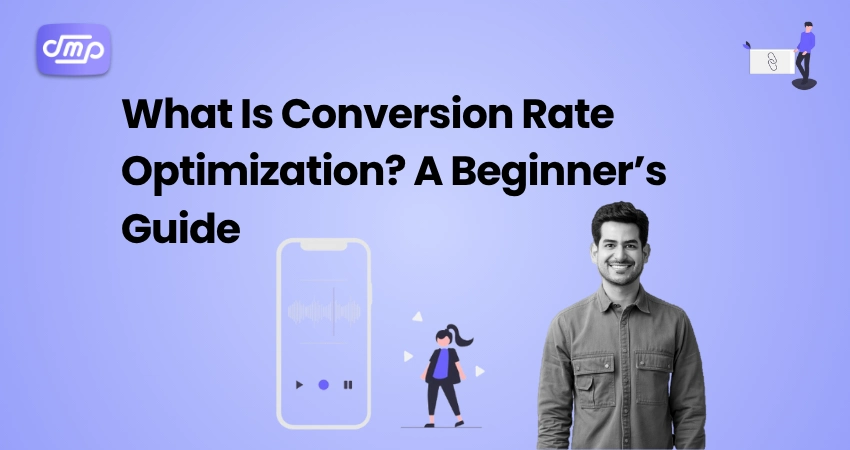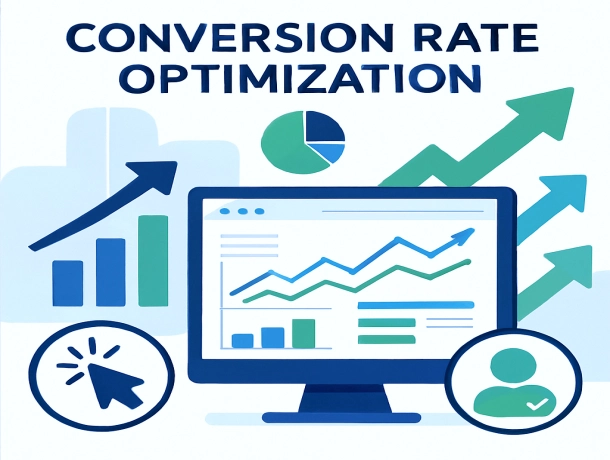
- May 13, 2025
- Digital Marketing, seo
- Search Engine Optimisation (SEO)
Table of Contents
Conversion Rate Optimization (CRO) is the process of enhancing your website or landing page so that more visitors take the intended action, such as making a purchase, signing up for a newsletter, or completing a contact form. Instead of focusing exclusively on increasing traffic, CRO tries to maximize existing traffic by improving user experience, testing new features (such as headlines, buttons, or layouts), and directing users more efficiently toward conversion goals.
Importance of CRO for Digital Marketing and Website Performance.

By optimizing how well your website converts users into leads or customers, CRO ensures that the traffic you presently have adds value. This results in a higher return on investment (ROI) for your marketing campaigns. It also improves the user experience by making your website more intuitive, faster, and easier to navigate, resulting in lower bounce rates and increased engagement. In summary, CRO allows you to accomplish more with less by converting clicks into meaningful actions.
What Is Conversion Rate Optimization (CRO)?
Conversion rate optimization (CRO) is the systematic process of increasing the percentage of website visitors that complete a desired action, sometimes known as a “conversion.” This could include actions like making a purchase, subscribing to a newsletter, downloading a file, or filling out a form.
Rather than simply attracting more visitors, CRO aims to increase the effectiveness of your existing traffic by enhancing the user journey, lowering friction, and testing various features. The goal is to improve user experience and more efficiently direct visitors to take action, thereby driving business growth without raising marketing cost.
Why Is CRO Important?
Conversion Rate Optimization is important since it allows you to maximize the value of your existing website visitors. Here’s why CRO matters:
- Improved ROI from marketing efforts: Rather than spending more money on marketing or recruiting new traffic, CRO allows you to generate more conversions from your existing visitors, increasing your return on investment.
- Improves user experience: CRO improves the usability of your website by monitoring user behavior and removing friction spots, allowing users to take action more easily.
- Reduces customer acquisition costs: Higher conversion rates reduce the cost of gaining each consumer, making your marketing budget more efficient.
- Increases revenue and business growth: Small gains in conversion rates can result in large revenue growth over time, particularly for e-commerce and service-based organizations. Data-driven CRO allows for deliberate website adjustments based on user behavior, eliminating guessing.
CRO allows you to work smarter, not harder, by optimizing how effectively your website converts visitors into customers or leads.
Key Elements of CRO
- Landing Page Design: First impressions count; clean, focused layouts with clear messaging increase engagement. Design elements should promote the page’s aim while reducing distractions.
- Call to Action (CTA): Strong, prominent, and appealing CTAs direct consumers to conversions. For optimal results, experiment with alternative languages, colors, and positioning.
- Forms: Short, straightforward, and user-friendly forms increase submission rates. Remove extraneous fields and apply clever formatting to reduce friction.
- Page Load Speed: Fast-loading pages increase user engagement and lower bounce rates. Site performance has a direct impact on conversion potential, particularly on mobile.
- Mobile responsiveness: A mobile-optimized experience is vital because a substantial percentage of people browse and convert on mobile devices.
- User Behavior Analytics: Heatmaps, scroll tracking, and session recordings are all tools that can demonstrate how users interact with your website. Determine pain points, drop-off locations, and chances for growth.
- A/B Testing: Systematically test alternative versions of pages, CTAs, and layouts to see what produces the best results. A data-driven approach for implementing changes with confidence.
- Trust Signals: Testimonials, reviews, security badges, and guarantees all help to establish confidence and eliminate hesitancy.
- Content and Copywriting: Clear, benefit-focused language piques curiosity and encourages action. Use convincing copy that addresses your audience’s pain points and goals.
Each of these factors contributes to a more seamless, persuasive user experience, hence enhancing your website’s capacity to convert visitors into leads or customers.
The CRO Process: Step-by-Step
The Conversion Rate Optimization (CRO) process begins with extensive research and data collection to better understand how users engage with your site. This entails evaluating critical metrics like bounce rates, exit pages, and user activity with tools like Google Analytics, Hotjar, and heatmaps. Once trends and pain points have been found, the next stage is to identify conversion bottlenecks—areas where visitors leave or pause. Based on these findings, you develop a hypothesis about what adjustments would increase performance, such as changing a call-to-action or streamlining a form.
Prioritize these adjustments by applying frameworks such as ICE (Impact, Confidence, Ease) to focus on high-impact, low-effort actions. Next, conduct A/B testing by comparing your existing version to a fresh variation to determine effectiveness. Analyze the test data to see which version performs best. If the new variation improves conversions, make it permanent. Finally, CRO is an ongoing process; regular monitoring and testing ensure that your site adjusts to changing user behavior and consistently delivers better results over time.
Common CRO Mistakes to Avoid

Here are some common Conversion Rate Optimization (CRO) mistakes to avoid so that your efforts result in real improvements:
- Skipping User Research: Jumping into modifications without first knowing user behavior frequently leads to poor conclusions. Always optimize based on data, not preconceptions.
- Testing Too Many Elements at Once: Multivariate testing with insufficient traffic can generate ambiguous findings. A/B testing can help you focus on one change at a time and gain clear information.
- Neglecting mobile optimization: Many organizations solely optimize for desktop users, despite the fact that mobile accounts for a significant portion of traffic and conversions.
- Not defining clear goals: Running tests without specified targets (for example, form submissions or purchases) makes it difficult to assess success or draw useful findings.
- Stopping Tests Too Early: Ending an A/B test before it reaches statistical significance might lead to false positives or misleading results.
- Ignoring Site Speed and Loading Time: A slow website drives visitors away. If users bounce before interacting, your optimization efforts will be ineffective.
- Using misleading CTAs: Clickbait or confusing calls-to-action may increase clicks, but they undermine confidence and lower actual conversions.
- Focusing solely on design: While visual appeal is important, CRO is also about messaging, functionality, and user experience.
- Failing to segment audiences: Treating all users equally can restrict outcomes. CRO is most effective when targeted to specific user categories, such as new vs. returning visitors or mobile vs. desktop users.
- Not continuing after a win: CRO isn’t a one-time task. Many businesses stop optimizing after one successful test rather than fostering a culture of continual improvement.
Conclusion
Conversion Rate Optimization (CRO) is a powerful method that enables you to maximize your existing website traffic by converting more users into customers or leads. Understanding user behavior, carefully testing changes, and avoiding common errors can help you drastically enhance the performance of your website and get more out of your digital marketing spending. Whether you’re just starting out or trying to scale, CRO should be a continuing aspect of your growth plan, with an emphasis on producing a seamless, user-friendly experience that produces results. Remember that even minor improvements in conversion rates can lead to significant gains over time.











